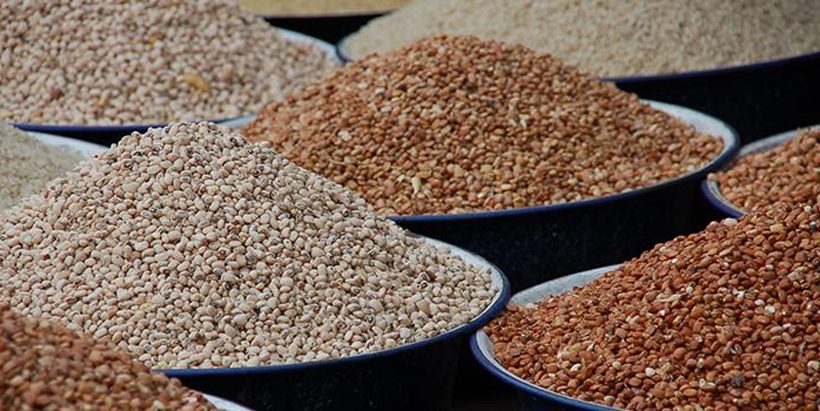29 July 2022
For a country with a population of over 19 million, the existing gaps in Zambia’s food system from production to consumption, especially in knowledge and output records, have a considerable effect on the agricultural value chain. Hence, the need to incorporate a variety of crops such as cowpea, a vital legume crop for Zambia, within the food system to complement several crops such as maize to improve nutrient intake and contribute to climate-smart and sustainable agricultural practices within communities in Zambia.
 Different cowpea varieties on display in a market
Different cowpea varieties on display in a market
As part of efforts to assemble pertinent information on cowpea and its value chain components in Zambia, a review titled, “Situational analyses on cowpea value chain in Zambia: the case of an untapped legume” was carried out. The review analysis was done by 10 scientists from six institutes in Southern Africa, including IITA–CGIAR’s Southern Africa, Research and Administration Hub (SARAH) Campus, and covered crop breeding, production, marketing, processing, and consumption as well as salient issues not often discussed on cowpea.
Cowpea, commonly known as the black-eyed pea, is a major legume crop for Zambia’s urban and rural households used as human and animal food. It is also a component of the agricultural production system, which improves the fertility of many depleted soils because of its ability to fix atmospheric nitrogen. It is relatively drought-tolerant and thrives in semi-arid regions of the tropics where other food legumes do not perform well.
Despite the valuable characteristics of cowpea, the crop’s value chain in Zambia has a wide range of aspects that needs to be addressed, such as delay in the release of varieties, low yield, and clean seeds. To address these issues, IITA-CGIAR focuses on strengthening the cowpea value chain, addressing nutrition, and combatting food insecurity using cutting-edge research and technologies being disseminated across Africa.
According to the review, agricultural policies that promote cowpea production and use and integrating a variety of crops within the food system to improve nutrient intake, amongst other relevant issues, would go a long way to improve livelihoods and well-being of millions in Zambia.
Local research tends to focus on high-yielding cowpea cultivar and germplasm development. The review recommends further studies on other important traits and improved methods of variety development that are vital to cowpea research programs. Breeding efforts should focus on climate resilience, pests, disease, water (drought tolerance), and nutrient use efficiency. In addition, end-user preferences should be a basis for variety selection to meet their needs and other industrial uses of cowpea. Similarly, potential markets need to be identified as these are potential production, consumption, and use boosters.
About 390,000 tons of cowpea is consumed in Africa. It is a crop worth investment and promotion in Zambia, hence public-private partnerships, especially with research institutes, should develop appropriate, affordable, and simple cowpea farming and utilization technologies. The accessibility and use of these simple technologies would significantly strengthen the cowpea value chain in the country.